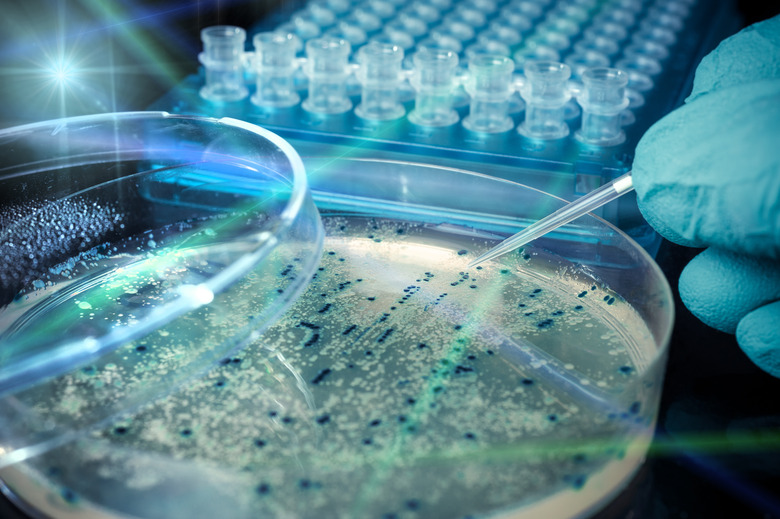Colony Characteristics Of E.Coli
Escherichia coli (commonly known as E. coli) are a large, varied group of bacteria found in the environment, foods and lower intestines of humans and animals. Most strains of E. coli are harmless, but some strains cause food poisoning in humans. A bacterial colony is a visible mass of microbial cells originating from one single cell. You can identify E. coli if you know its colony characteristics.
TL;DR (Too Long; Didn't Read)
E. coli colonies are off-white, dry in texture, with a steady growth pattern. E. coli colonies have no pigment, but change color when transformed by a plasmid.
Arrangement and Size
Arrangement and Size
The arrangement and size of an E. coli colony are not reliable characteristics. The arrangement – how close together or far apart the bacteria are is due to how they were streaked on the plate. Colony size can vary because a colony is larger if it's more spread out. Color, texture and growth pattern are better colony characteristics to observe.
Color, Texture and Growth Pattern
Color, Texture and Growth Pattern
An E. coli colony is off-white or beige in color with a shiny texture. It often looks like mucus or a cloudy film over the whole surface of the plate. An E. coli colony is slightly raised and has an entire, fixed margin and a steady growth pattern, creating concentric growth rings in the colony. You can detect these rings under a microscope. Older colonies often have a darker center.
E. Coli Cells
E. Coli Cells
Bacteria are unicellular microorganisms with no chlorophyll pigments. There are no nucleus or membrane-bound organelles, so the cell structure is simpler than that of other organisms. All bacteria have a rigid cell wall, meaning they maintain a definite cell shape. E. coli cells are bacillus (rod-shaped) and typically occur individually and in large clumps. The average size of the rod is 1.1 to 1.5 µm wide by 2.0 to 6.0 µm long.
Transforming E. Coli
Transforming E. Coli
Unlike some other bacteria, E. coli have no pigment, so their colonies are lacking in color. However, you can give E. coli a plasmid (a small, circular strand of DNA) that includes a color marker to transform it. Successful E. coli transformations create colored colonies on some media. For example, growth on a MacConkey agar plate shows that E. coli are not inhibited by bile salts and crystal violet. The pink color of the bacterial growth indicates E. coli can ferment lactose and tells you that it is a gram-negative bacterium.
Cite This Article
MLA
Gillespie, Claire. "Colony Characteristics Of E.Coli" sciencing.com, https://www.sciencing.com/colony-characteristics-ecoli-8507841/. 13 April 2018.
APA
Gillespie, Claire. (2018, April 13). Colony Characteristics Of E.Coli. sciencing.com. Retrieved from https://www.sciencing.com/colony-characteristics-ecoli-8507841/
Chicago
Gillespie, Claire. Colony Characteristics Of E.Coli last modified March 24, 2022. https://www.sciencing.com/colony-characteristics-ecoli-8507841/
